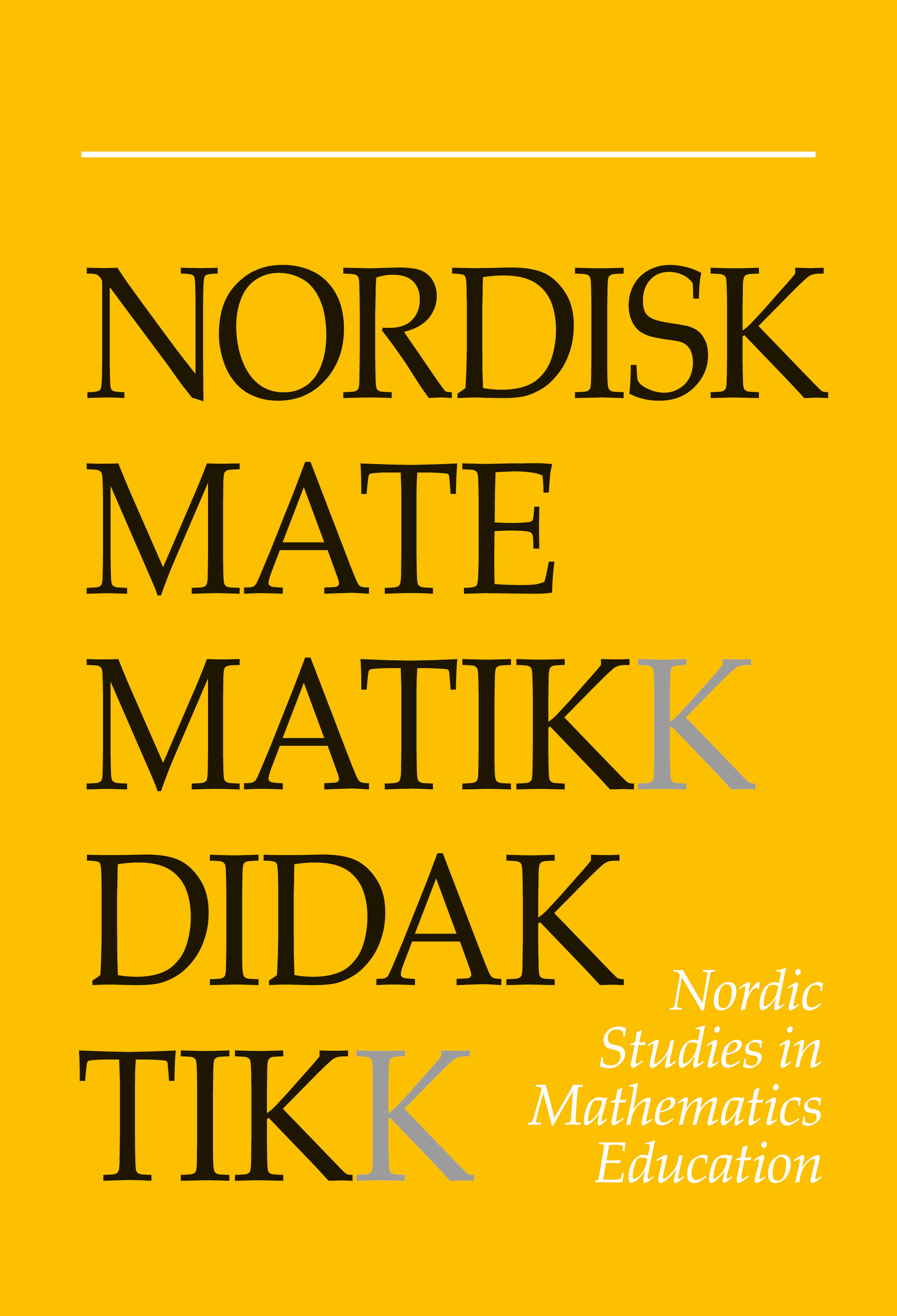Creative and conceptual challenges in mathematical problem solving
DOI:
https://doi.org/10.7146/nomad.v27i3.149238Abstract
Mathematical problem solving has proven to be valuable for students’ learning. Yet, problem solving is often referred to and discussed without distinguishing between creative and conceptual aspects. The purpose of this study is to advance understanding of mathematical problem solving through the analysis of students’ work with mathematical problems in terms of the creative and conceptual challenges they encounter. It is proposed that the characteristics of creative challenges can be used to obtain a more detailed description of the problem-solving process. Furthermore, the characteristics of conceptual challenges can provide a basis for discussion of what conceptual understanding may entail. Moreover, the analytic framework developed in this study is proven to be of assistance in the visualization of challenges and may be useful in future efforts to investigate challenges and students’ problem solving in mathematics.
References
Bingolbali, E. & Monaghan, J. (2008). Concept image revisited. Educational Studies in Mathematics, 68 (1), 19-35. https://doi.org/10.1007/s10649-007-9112-2
Canton, B.J., Etienne, S., Huyck, H., Santarelli, J. & Stewart, K. (2007). Foundations of Mathematics 10. McGraw-Hill Ryerson.
Carlsson, S., Hake, K. & Öberg, B. (2010). Matte Direkt 8. Sanoma utbildning. Creswell, J. W. (2008). Educational research: planning, conducting, and evaluating quantitative and qualitative research. Pearson Education.
Dalarna University (May 12, 2022). Ethics in research projects. https://www.du.se/en/medarbetarwebb/forska-och-utbilda/forskningsstod/ethics-in-research-projects/
Dìaz-Obando, E., Plasencia-Cruz, I. & Solano-Alvarado, A. (2003). The impact of beliefs in student's learning: an investigation with students of two different contexts. International Journal of Mathematical Education in Science and Technology, 34 (2), 161-173. https://doi.org/10.1080/0020739031000071476
Hiebert, J. & Grouws, D. (2007). The effects of classroom mathematics teaching on students learning. In F. K. Lester (Ed.), Second handbook of research on mathematics teaching and learning: a project of the national council of teachers of mathematics (pp. 371-404). Information Age Pub.
Hiebert, J. & Lefevre, P. (1986). Conceptual and procedural knowledge in mathematics: an introductory analysis. In J. Hiebert (Ed.), Conceptual and procedural knowledge: the case of mathematics (pp. 1-27). Erlbaum.
Johnson, H. L., Coles, A. & Clarke, D. (2017). Mathematical tasks and the student: navigating "tension of intentions" between designers, teachers, and students. ZDM, 49 (6), 813-822. https://doi.org/10.1007/s11858-017-0894-0
Jonsson, B., Norqvist, M., Liljekvist, Y. & Lithner, J. (2014). Learning mathematics through algorithmic and creative reasoning. The Journal of Mathematical Behavior, 36, 20-32. https://doi.org/10.1016/j.jmathb.2014.08.003
Jäder, J., Sidenvall, J. & Sumpter, L. (2017). Students' mathematical reasoning and beliefs in non-routine task solving. International Journal of Science and Mathematics Education, 15 (4), 759-776. https://doi.org/10.1007/s10763-016-9712-3
Kilpatrick, J., Swafford, J. & Findell, B. (2001). Adding it up: helping children learn mathematics. National Academy Press.
Lithner, J. (2008). A research framework for creative and imitative reasoning. Educational Studies in Mathematics, 67 (3), 255-276. https://doi.org/10.1007/s10649-007-9104-2
Lithner, J. (2017). Principles for designing mathematical tasks that enhance imitative and creative reasoning. ZDM, 49(6), 937-949. https://doi.org/10.1007/s11858-017-0867-3
Maciejewski, W. (2017). Mathematial knowledge as memories of mathematics. In B. Kaur, W. K. Ho, T. L. Toh & B. H. Choy (Eds.), Proceedings of the 41st conference of the international group for the psychology of mathematics education (Vol 3, pp. 209-216). PME.
Niss, M. (2003a). The Danish KOM project and possible consequences for teacher education. In R. Strässer, G. Brandell, B. Grevholm & O. Helenius (Eds.), Educating for the future: proceedings of an international symposium on mathematics teacher education (pp. 179-190). Kungliga Vetenskapsakademin.
Niss, M. (2003b). The mathematical competencies and the learning of mathematics: the Danish KOM project. In A. Gagtsis & S.G. Papastavridis (Eds.), Third Mediterranean conference on mathematical education (pp. 115- 124). The Hellenic mathematical society.
Niss, M. (2006). The structure of mathematics and its influence on the learning process. In J. Maasz & W. Schloeglmann (Eds.), New mathematics education research and practice (pp. 51-62). Sense Publishers. https://doi.org/10.1163/9789087903510_007
Olsson, J. (2019). Relations between task design and students' utilization of GeoGebra. Digital Experiences in Mathematics Education, 5 (3), 223-251. https://doi.org/10.1007/s40751-019-00051-6
Robson, C. (2011). Real world research. Wiley.
Russo, J. & Hopkins, S. (2017). Student reflections on learning with challenging tasks: "I think the worksheets were just for practice, and the challenges were for maths". Mathematics Education Research Journal, 29(3), 283-311. https://doi.org/10.1007/s13394-017-0197-3
Schmidt, W. H., McKnight, C. C., Houang, R. T., Wang, H., Wiley, D. E. et al. (2001). Why schools matter: a cross-national comparison of curriculum and learning. The Jossey-Bass education series.
Schoenfeld, A. H. (1985a). Mathematical problem solving. Academic Press.
Schoenfeld, A. H. (1985b). Making sense of "out loud" problem-solving protocols. The Journal of Mathematical Behavior, 4 (2), 171-191.
Schoenfeld, A. H. (2017). On learning and assessment. Assessment in Education: Principles, Policy & Practice, 24 (3), 369-378. https://doi.org/10.1080/0969594X.2017.1336986
Silver, E. A. (1997). Fostering creativity through instruction rich in mathematical problem solving and problem posing. ZDM, 29(3), 75-80. https://doi.org/10.1007/s11858-997-0003-x
Simon, M. A. & Tzur, R. (2004). Explicating the role of mathematical tasks in conceptual learning: an elaboration of the hypothetical learning trajectory. Mathematical Thinking and Learning, 6 (2), 91-104. https://doi.org/10.1207/s15327833mtl0602_2
Skolverket (2010). Nationellt kursprov i matematik, kurs A, våren 2010, del I [National test in Mathematics]. Skolverket.
Sullivan, P., Askew, M., Cheeseman, J., Clarke, D., Mornane, A. et al. (2015). Supporting teachers in structuring mathematics lessons involving challenging tasks. Journal of Mathematics Teacher Education, 18 (2), 123-140. https://doi.org/10.1007/s10857-014-9279-2
Tall, D. & Vinner, S. (1981). Concept image and concept definition in mathematics with particular reference to limits and continuity. Educational Studies in Mathematics,12 (2), 151-169. https://doi.org/10.1007/BF00305619
Terwel, J., Oers, B. van, Dijk, I. van & Eeden, P. van den (2009). Are representations to be provided or generated in primary mathematics education? Effects on transfer. Educational Research and Evaluation, 15 (1), 25-44. https://doi.org/10.1080/13803610802481265
Vetenskapsrådet. (2017). God forskningssed. Vetenskapsrådet.
Wedman, L. (2020). The concept concept in mathematics education: a concept analysis [Ph. D. thesis]. Acta Universitatis Gothoburgensis.
Zaslavsky, O. (2005). Seizing the opportunity to create uncertainty in learning mathematics. Educational Studies in Mathematics, 60 (3), 297-321. https://doi.org/10.1007/s10649-005-0606-5
Downloads
Published
How to Cite
Issue
Section
License

This work is licensed under a Creative Commons Attribution-NonCommercial-ShareAlike 4.0 International License.



